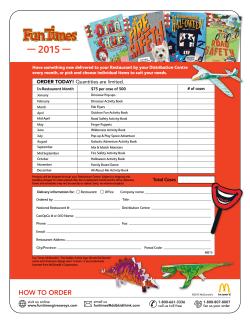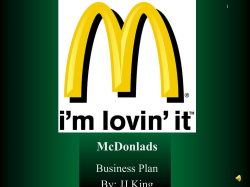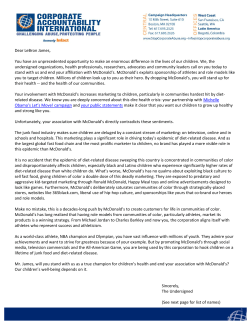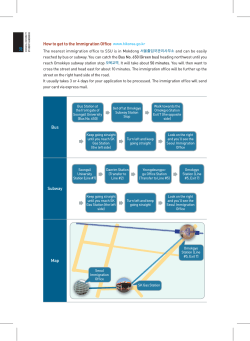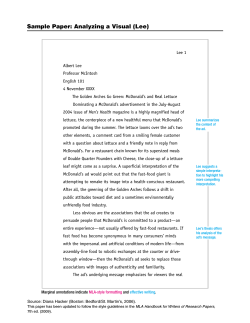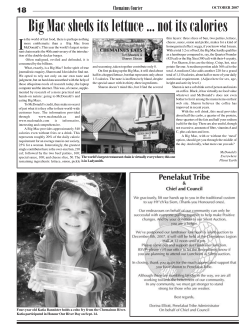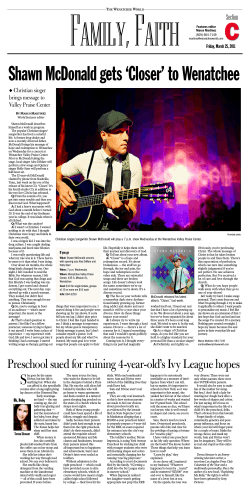
DIFFERENTIATION & POSITIONING OF FAST FOOD COMPANY
DIFFERENTIATION & POSITIONING OF FAST FOOD COMPANY Fast food Professor: Cheng – Nan Chen Students: Lim Veron Nardy –M987Z210 Yoseph Kaburuan –M987Z213 Sermsri C. –M987Z220 Lee Po Kun –M9870114 Nguyen Duy –M987Z218 Pham Thi Nguyet –M987Z241 CONTENTS Introduction Previous position and challenges Marketing Environment (Micro & Macro) Subway SWOT analysis New strategy to repositioning – differentiation Conclusion and Recomendation Question Discussion INTRODUCTION-FAST FOOD Fast food is the term given to food that can be prepared and served very quickly. Fast Services Food = General term used for a limited menu of foods that lend themselves to production-line techniques; suppliers tend to specialize in products such as hamburger, pizzas, chicken, or sandwiches. Fred DeLuca founded the SUBWAY® chain in Connecticut, USA, in 1965. The company has since grown into a multi-billion pound business, with 31,949 outlets in 91 countries. The SUBWAY® chain aims to increase the number of outlets it has in the UK and Ireland to over 2,000 stores by 2010. In 2009, the SUBWAY® chain was ranked the number one franchise opportunity by Entrepreneur Magazine. In 2008, the SUBWAY® chain was voted the No. 1 sandwich provider in the British Sandwich Association’s (BSA) sandwich industry report. In most years, about 70% of new SUBWAY® franchises are sold to existing SUBWAY® owners. The low fat menu is popular with customers all around the world. JARED FOGLE Diet Start Date: MidMarch 1998 Height: 6' 2'' Starting weight: 425 pounds Current weight: 190 pounds The Jared Diet: New healthier sandwiches: less than 7 grams of fat Menu for lunch: Six-inch turkey, no mayo, no oil, hold the cheese Menu for dinner: A footlong veggie, baked potato chips, diet beverage MCDONALD’S Background - The McDonald's Story The McDonald's story began in 1940 when Dick and Mac McDonald opened a highly successful car-hop, barbecue restaurant in San Bernardino, Calif. They temporarily closed their restaurant, built a simplified menu around their best-liked products, designed a more efficient interior and re-opened with self-service at the former car hop windows. McDonald’s Thus, they invented the self-service, drive-in concept that was a limited-menu, paperservice, hand-out operation, featuring 15-cent hamburgers, 19-cent cheeseburgers, 20-cent malts and 10-cent French fries. After a slow start, business boomed. In 1952, American Restaurant Magazine ran a cover story on the phenomenal success of the brother's new concept. McDonald’s In 1955, Ray was granted exclusive rights by the brothers to develop and franchise McDonald's drive-ins for the United States. Ray formed McDonald's System, Inc. in 1955. Ray opened the 9th McDonald's, his first, in Des Plaines, IL, in April 1955. In 1961, Ray bought from the McDonald's brothers the proprietary rights to the McDonald's system, including all rights to the rest of the world. The organization that Ray founded -today's McDonald's Corporation -- proceeded to add more than 23,000 McDonald's restaurants and 4,500 franchisees across more than 111 countries around the world. MCDONALD’S STRANGE MENU AROUND THE WORLD India In India, there are no Big Macs because the Hindu people don’t eat beef. However, they have the Maharaja Mac, which is a Big Mac made of lamb or chicken meat. There is also a vegetarian burger, the McAloo Tikki. MCDONALD’S STRANGE MENU AROUND THE WORLD Germany It’s bottoms up in Germany, where McDonald’s serves – Beer! MCDONALD’S STRANGE MENU AROUND THE WORLD CANADA In parts of Canada, have a lobster dinner with the McLobster lobster roll. Pardon me – “McHomard” (in French). MCDONALD’S STRANGE MENU AROUND THE WORLD JAPAN Japan totally reinvents McDonald’s with its Ebi Filet-O (shrimp burgers), Koroke Burger (mashed potato, cabbage and katsu sauce, all in a sandwich), Ebi-Chiki (shrimp nuggets) and Green Tea-flavored milkshake! MCDONALD’S STRANGE MENU AROUND THE WORLD NORWAY In fish-loving Norway, they have the McLaks, a sandwich made of grilled salmon and dill sauce. MCDONALD’S STRANGE MENU AROUND THE WORLD HONG KONG Rice-loving Hong Kong, has – of course – Rice Burgers, where the burgers are in between, not burger buns, but two patties of glutinous rice. PREVIOUS POSITION & CHALLENGES Subway Create brand name relied on one main kind of product (foot long sandwich) Was known more for its belly-busting foot long sandwiches and its gaudy yellow décor than for anything else Accessible (subway stations) For the busy and on-the-go people who have to eat on the way to work. CHALLENGES - SUBWAY Subway needed a makeover A new positioning in the marketplace – something that would distinguish Subway from its fat and sugar purveying competitor Market wants fresher, healthier menu. Challenges Many people have diseases that are linked to eating fast foods such as obesity and diabetes. The Subway stores are not welcoming- the place are damped and the service crews were not very courteous. MCDONALD’S A truly global company: present in 118 countries But does not guarantee success Last quarter 2002 loss for the first time Where might it be wrong CHALLENGES – MCDONALD’S Consumers want and need: increasingly want variety and are becoming much more health conscious Mc Donald’s has been taken to court with the issue their food can lead to obesity. They have neglected the competition of other fast food chains which could give the customers an alternative. 1980s, increased new store openings that made a loss of profitability. Environment: Be challenged in some country markets local company Poor Consumer Satisfaction Index: Survey in 2001 Lawsuits: McDonald’s caused obesity in children due to the high sugar and fats in their burgers and foods MACRO ENVIRONMENT DEMOGRAPHIC ENVIRONMENT * Age Structure Young people become the target of fast food industry. The younger the person, the more they eat out at fast food restaurants. *Working Woman The increasing number of working woman, makes the need of fast food service growing. MACRO ENVIRONMENT (CONT.) CULTURAL ENVIRONMENT The young people attend to eat together with friends or co-workers. The raise of health consciousness. The need of natural product and demand from customer for company MACRO ENVIRONMENT (CONT.) ECONOMIC ENVIRONMENT Families that have more money eat out more. The larger the family, the less they eat out, but the times they do eat out, they visit fast-food restaurants more. People spend more money on fast food than they do on higher education, personal computers, software or new cars. They spend more on fast food than on movies, books, magazines, newspapers, videos and recorded music - combined. MICRO ENVIRONMENT COMPANY – TOP MANAGEMENT Mission Healthy food – healthy world Objective - One of the world’s fastest growing industries - Provide quality fast food with international standards, taste and freshness Broad strategies - Remake image - Reposition for a global future - Sign up franchisees and open new stores as more as possible - Build up the reseller and wholesaler system all over the world Policies - Quality – safe – clean - High brand awareness and preference MICRO ENVIRONMENT CUSTOMER CONSUMER MARKET Pay attention to special customer segment in each country, each city and each area. There are many demands, needs and wants in each area. Fast food company makes use of the characteristics, culture and taste to develop product suitable to customers there. INTERNATIONAL MARKET The market is very important for a fast food company to maintain its position worldwide and obtain customers. - McDonalds has set up 31,000 location worldwide. BUSINESS MARKET To develop this market, fast food companies almost use “franchisees” as marketing strategy to find out and set up restaurant system globally MICRO ENVIRONMENT (CONT.) COMPETITOR Most of fast food companies have competitive marketing strategy globally to get the target - “Become the number one position in fast food industry” with healthy product. Franchisee is one of the most popular meanings in marketing strategy. Build up the large restaurant system as more as stronger. List of fast food restaurants: McDonald’s Burger King Subway Pizza Hut Yum! A&W Restaurants And so forth. MICRO ENVIRONMENT (CONT.) MEDIA PUBLICS Is the most popular means of advertisement to make strong impression on fast food customers, especially children. Ads are often full of color, photo and logo; moreover, having special, impressive and exclusive thing. Included: television, website, magazines, billboard, and so forth. SUBWAY SWOT ANALYSISSTRENGTH 1.Image The essentials of the Subway “eat fresh” Image 2. Transparency of Preparation At Subway Restaurants you can see all ingredients YOU choose for your Sandwich. You can observe every step of preparation in front of you You are always asked for every single vegetable in order to focus you on the “live preparation” 3.Emotional and psychological items The colours and materials that are used for furnishing & the design elements of a Subway Restaurant are always natural: wood tones, brown, green and red SUBWAY SWOT ANALYSIS-WEAKNESSES Its competitor, such as McDonalds, provide sophisticated service 24 hours open focusing on people want to diet OPPORTUNITY health eat style is a trend In some country, subway is not very well-known SUBWAY SWOT ANALYSIS-THREATS Shops fast food appear more and more over the world Competitor: Reduce price: McDonald’s retaliated by reducing the price of it burger to 99 cents in the US and 99 pence in the UK. Understand customer’s need: Jollibee in the Philippines, which had a similar business model to McDonald’s, offered adaptation, such as spicy sauces that appealed to the local markets New strategy to repositioning Transparency of Preparation • • • • All ingredients for your Sandwich. Observe every step of preparation “live preparation” The nutritional information provided for insight and online Emotional and psychological items • The nature color materials: wood tones, brown, green and red • Subway Restaurant surrounding: eating food and fresh food. • Friendly atmosphere and a feeling of trust US TV Commercial Series “Subway Dinner Theatre” Three TV spots for three target groups Three different situations Three main messages: Value and quality; Subs are easy and fast to get; non-comlexity of eating at a Subway restaurant The testimonal: Every TV spot has an intro with a well known person who identifies himself with Subway food. At the end of every TV spot he speaks out the Subway Slogan “eat fresh” Repositioning Update the stores’ interiors Open new Subway’s stores in US and abroad Using the images of fresh tomatoes and other vegetables in New York subways system Personality & Character At MD the emotional “free like home” and “have fun” messages are dominant. No transparency of preparation, BUT engagement and friendship giving the customer confidence concerning healthy food. No direct “fresh” and “healthy” attributes in main advertisement – fact treated as an assumption Sports & Activities Associates Healthy Nutrition • • • • MD sponsors lots of sports events and charity events The engagement in indirect ads for a life style that MD identifies with. Meeting point for young people who want to have fun combined with easy and fast food Supporting various events MD uses the media to push its image and make the name omnipresent – no chance to escape Some activities and PR campaigns in 2006 “Bag a meal” “Who’s next basketbal” “Sports” “I am Asian” Main Target Group • • Young people People at work, health conscious of Subway Association & Sponsorships • • Children, young people People at work, on vacation, eating for fun RECOMMENDATION AND CONCLUSION McDonald’s has improved their menus by adding up fresh green salad, which implies healthiness. • Aside from this, they could adapt into the environment where they are in and give out tastes that could relate to different countries. • Fast food industry has to supply various products and they are much more healthy. • Due to fast food, people do not have to spend more as much time on making their own food, doing their taxed or travel. • Fast food companies has been conducting marketing strategy to create new image and reposition for a global future. •Franchise is a global system to build up a global brand in fast food industry. • Question Discussion QUESTION 1: WHAT DO YOU CONSIDER TO BE THE DEFINITION OF GLOBALISATION? WHAT FORCES ARE DRIVING ITS DEVELOPMENT? Answer: Globalization is the system of interaction among the countries of the world in order to develop the global economy. 2 main forces are driving it: The development in fast technology Condition of economy. QUESTION 2: IDENTIFY THE REASONS WHY GLOBAL STRATEGIES SOMETIMES FAIL IN THEIR OBJECTIVE TO ACHIEVE A GLOBAL MARKETING ADVANTAGE? Answer: Because the global strategies only focus on enlarging more and more stores over the world, this make a surplus to customer demand while they don’t focus on caring much about the change in eating tendency of customer . QUESTION 3 WHAT IS THE RATIONALE BEHIND MEGA MERGERS AND MAJOR ACQUISITIONS? HOW WILL THEY LEAD TO GLOBAL COMPETITIVE ADVANTAGE? Answer: International Competition. Mergers can help firms deal with the threat of multinationals and compete on an international scale Mergers may allow greater investment in R&D This is because the new firm will have more profit. This can lead to a better quality of goods for consumers Greater Efficiency. Redundancies can be merited if they can be employed more efficiently QUESTION 4 WHAT ARE THE CRITICAL SUCCESS FACTORS IN DEVELOPING A GLOBAL BRAND? WHAT ADDITIONAL FACTORS WOULD YOU CONSIDER TO BE NECESSARY IN DEVELOPING A SUCCESSFUL GLOBAL E-BUSINESS BRAND? Answer: Critical success factors: adapting the strategy to country-specific situations effectively communicating the brand across the world (both within and outside the organization). Successful global e-business brand QUESTION 5 WHAT ARE THE MAIN CHALLENGES THAT ARE FACED BY INTERNATIONAL MANAGERS IN MANAGING AND CONTROLLING A GLOBAL MARKETING STRATEGY? WHAT ADVICE WOULD YOU GIVE TO A MANAGER WITH THIS RESPONSIBILITY? Cultural and environmental differences are the main challenges that are faced by international managers in managing and controlling a global marketing strategy. Key words include eating habits, GDP, economic, political situation competition. For example, Different countries have different eating habits. The Chinese have a saying “Good things for breakfast. Eating a big meal for lunch but eating less at dinner.” CON’T Many Americans agree that one should start the day with a good breakfast, but their ideas about lunch and dinner are different. Most Americans only give themselves a short time for lunch. So they eat a small lunch. After work they will have more time to eat a big dinner. Also a quiet dinner at home with all family talking about their day is a way to take a good rest after a long, hard day of work. The manager must monitor environments which impact consumer behavior very closely, in order to develop forecasts, goals, and plans for international activities. 謝謝 有問題嗎?
© Copyright 2026
